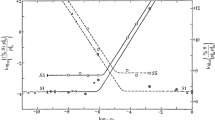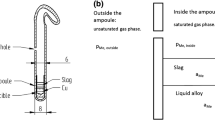Abstract
Sulfur dissolution behavior, in terms of sulfide capacity (C S), in ternary silicate slags (molten oxide slags composed of MO – NO – SiO2, where M and N are Ca, Mn, Fe, and Mg), is discussed based on available experimental data. Composition dependence of the sulfur dissolution, at least in the dilute region of sulfur, may be explained by taking into account the cation–anion first-nearest-neighbor (FNN) interaction (stability of sulfide) and the cation–cation second-nearest-neighbor (SNN) interaction over O anion (oxygen proportions in silicate slags). When the Gibbs energy of a reciprocal reaction MO + NS = MS + NO is positive, the sulfide capacity of slags with virtually no SiO2 or low SiO2 concentration decreases as the concentration of MO increases. However, in some slags, as SiO2 concentration increases, replacing NO by MO at a constant SiO2 concentration may increase sulfide capacity when the basicity of NO is less than that of MO. This phenomenon is observed as rotation of iso-C S lines in ternary silicate slags, and it is explained by simultaneous consideration of the stability of sulfide and oxygen proportions in the silicate slags. It is suggested that a solution model for the prediction of sulfide capacity should be based on the actual dissolution mechanism of sulfur rather than on the simple empirical correlation.





Similar content being viewed by others
Notes
Note: Through the current article, only sulfide is considered as a species dissolving in molten oxide. Sulfate (SO4 2–), pyrosulfate (S2O7 2–), etc. are not considered, as our concern is given to sulfur dissolution under reducing atmosphere.
References
G.-H. Park, Y.-B. Kang, and J.H. Park: ISIJ Int., 2011, vol. 51 (9).
C.J.B. Fincham and F.D. Richardson: J. Iron Steel Inst., 1954, vol. 178, pp. 4-15.
C.J.B. Fincham and F.D. Richardson: Proc. R. Soc., London, 1954, vol. 223A, pp. 40-62.
K.P. Abraham, M.W. Davies, and F.D. Richardson: J. Iron Steel Inst., 1960, vol. 196, pp. 309-12.
A. Bronson and G.R. St. Pierre: Metall. Trans. B, 1981, vol. 12B, pp. 729–31.
M.M. Nzotta, D. Sichen, and S. Seetharaman: Metall. Mater. Trans. B, 1999, vol. 30B, pp. 909-20.
D.J. Sosinsky and I.D. Sommerville: Metall. Trans. B, 1986, vol. 17B, pp. 331-37.
A.D. Pelton, P. Chartrand, and G. Eriksson: Metall. Mater. Trans. A, 2001, vol. 32A, pp. 1409-16.
Y.-B. Kang and A.D. Pelton: Metall. Mater. Trans. B, 2009, vol. 30B, pp. 979-94.
C. Bale, P. Chartrand, S. Degterov, G. Eriksson, K. Hack, R.B. Mahfoud, J. Melançon, A. Pelton, and S. Petersen: CALPHAD, 2002, vol. 26, pp. 189-228.
C.W. Bale, E. Bélisle, P. Chartrand, S.A. Decterov, G. Eriksson, K. Hack, I.-H. Jung, Y.-B. Kang, J. Melançon, A.D. Pelton, C. Robelin, and S. Petersen: CALPHAD, 2009, vol. 33, pp. 295-311.
O.J. Kleppa: Molten Salt Chemistry. An Introduction and Selected Applications, G. Mamantov, R. Marassi, D. Reidel, eds., Springer, Dordrecht, The Netherlands, 1987, p. 17.
H. Flood, T. Førland, and K. Motzfeldt: Acta Chem. Scand., 1952, vol. 6, pp. 257-69.
P. Wu, G. Eriksson, and A.D. Pelton: J. Am. Ceram. Soc., 1993, vol. 76, pp. 2065-75.
M.M. Nzotta, R. Nilsson, D. Sichen, and S. Seetharaman: Ironmaking Steelmaking, 1997, vol. 24, pp. 300-05.
R.A. Sharma and F.D. Richardson: Trans. TMS-AIME, 1965, vol. 223, pp. 1586-92.
M. Gornerup and O. Wijk: Scand. J. Metall., 1996, vol. 25, pp. 103-07.
G. Eriksson, P. Wu, M. Blander, and A.D. Pelton: Can. Metall. Q., 1994, vol. 33, pp. 13-22.
Y. Tsunawaki, N. Iwamoto, T. Hattori, and A. Mitsuishi: J. Non Crystalline Solids, 1981, vol. 44, pp. 369-78.
J.H. Park and C.H. Rhee: J. Non Crystalline Solids, 2001, vol. 282, pp. 7-14.
M. Nzotta: Scand. J. Metall., 1997, vol. 26, pp. 169-77.
S.R. Simeonov, R. Sridhar, and J.M. Toguri: Metall. Mater. Trans. B., 1995, vol. 26B, pp. 325-34.
P. Wu, G. Eriksson, A.D. Pelton, and M. Blander: ISIJ Int., 1993, vol. 33, pp. 26-35.
E. Jak, P. Hayes, A. Pelton, and S. Decterov: Int. J. Mater. Res., 2007, vol. 98, pp. 847-54.
Y.-B. Kang, I.-H. Jung, S.A. Decterov, A.D. Pelton, and H.-G. Lee: ISIJ Int., 2004, vol. 44, pp. 965-74.
J.A. Duffy and M.D. Ingram: J. Am. Chem. Soc., 1971, vol. 93, pp. 6448-54.
Author information
Authors and Affiliations
Corresponding author
Additional information
Manuscript submitted March 29, 2011.
An erratum to this article can be found at http://dx.doi.org/10.1007/s11663-011-9595-1
Rights and permissions
About this article
Cite this article
Kang, YB., Park, J.H. On the Dissolution Behavior of Sulfur in Ternary Silicate Slags. Metall Mater Trans B 42, 1211–1217 (2011). https://doi.org/10.1007/s11663-011-9541-2
Published:
Issue Date:
DOI: https://doi.org/10.1007/s11663-011-9541-2




